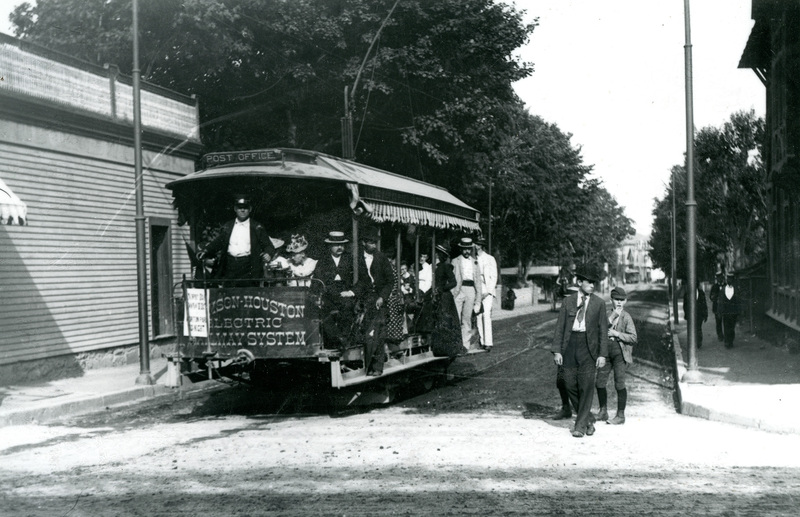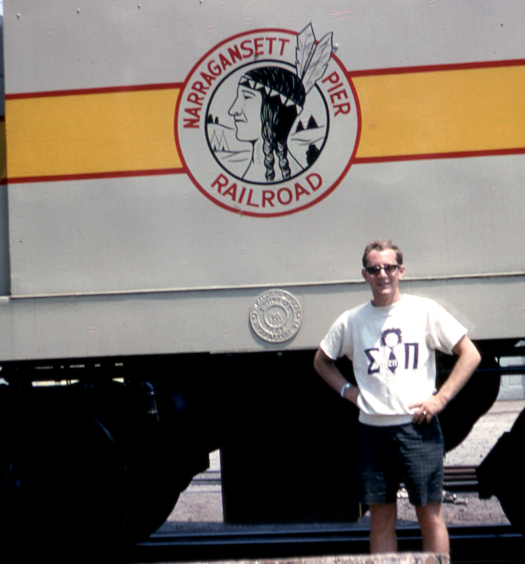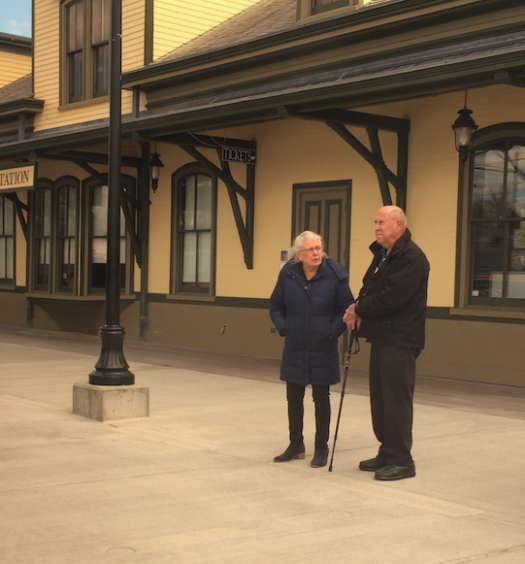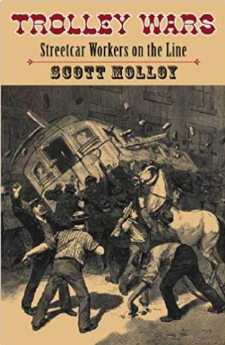The character and deportment of the Union Railroad’s drivers and conductors won the carrier legions of patrons. The horsecar enterprise, however, was an urban system that operated within a few miles of downtown Providence until the coming of the electric streetcar in 1892 to the capital city. The Union Railroad did not pay much attention to several suburban horsecar competitors, most notably in Pawtucket and Woonsocket. Although the “riding habit” was catching on in Gilded Age America, the tame five mile-per-hour speed limits were just too slow to win the total fancy of the public. All that changed in Rhode Island in 1887 when the upstart Woonsocket horsecar operation shocked the state when it switched to the emerging but untested electric trolley system.

A trolley system was first used in Woonsocket, but it was more for amusement and lasted only a few months. This photograph of a later electric trolley shows the Woonsocket Street Railway. “Woonsocket” is printed on the front of the car and “Pascoag” is on the destination placard (Providence Public Library Digital Collections)
Perched against the Massachusetts border, the northern town of Woonsocket startled all of New England as well when it initiated the first electric streetcar route in the region. Woonsocket, with a population of only 16,199 in 1885, seemed ill fitted as a technological laboratory, especially when Providence hosted 100,000 more inhabitants. The town’s horsecar system had only been in operation a few months when the trolley experiment began. America’s inaugural revenue trolleys had sparked down the streets of Montgomery, Alabama, only a year earlier.
The Rhode Island General Assembly incorporated the Woonsocket Street Railway Company in 1886. Nothing in the enabling-legislation stipulated a particular means of power, although horsecars ran initially on August 4,1887. Six drivers and conductors manned the railway’s only two horsecars from 5:45 a.m. to 11:00 p.m. One conductor took in $10 in nickel fares in four hours the first day. There were only two lines, Social and North Main, and no set schedule. The state railroad commissioner reported a modest operation there a year before Woonsocket was actually incorporated as a city in 1888. The company owned a total of 38 horses and less than five miles of track. Within a week of horsecar service, the owners strung a network of wires above the routes, “a sight to see,” according to the Providence Journal, which commended the small corporation for such an enterprising venture.
On September 25, 1887 a “juice car” or trolleys started service in Woonsocket. The car ran less than a mile along South Main Street, past the Woonsocket Rubber Works where passengers had to push it back on the tracks after derailing, and then smoothly up Globe Hill before an astonished crowd of onlookers. The ride became a novelty and amusement rather than a practical means of transportation on such a short line. Some joy seekers used a dollar’s worth of five cent rides in an hour. The Associated Press issued daily reports, and entrepreneurs from throughout the United States inspected the operation. The primitive trolley, unlike later versions, did not employ the familiar “broomstick” trolley pole that connected an overhead wiring system to the car. Instead, a small “truck” ran atop the electrical wire. A limp wire hung down to power the streetcar below.
The experiment lasted a few months. Local businessmen began a petition against electric streetcars saying the vehicles scared horses and frightened customers away. Woonsocket residents, unaccustomed to street rails, reacted like Providence residents a few decades earlier. One teamster “gave vent to some illuminated French condemnation of the rails.” In November one of the cars caught fire when sparks from overhead wires ignited a canvas motor cover on the trolley. The fire department complained of dangerous live wires that could hinder firefighting efforts by blocking ladders. Confusion over interfacing horsecars with electric streetcars caused one conductor to quit on the spot rather than suffer passenger abuse. Furthermore, the company ordered only open cars, which took the joy out of riding as the warm days of summer gave way to a brisk November chill.
The Woonsocket experiment, despite technical shortcomings and citizen shortsightedness, offered a glimpse of future transportation. The owners used technology that had been developed since 1883 at the Rhode Island Locomotive Works for the Bentley-Knight Company of New York which supplied the undertruck of streetcars. The locomotive works had experimented with electrical propulsion at the same time it produced some of the best steam locomotives in the country. The Providence Journal declared “the contest of the future, then, is not between electricity and the horse, but between electric cars and electricians.” The superintendent of the Union Railroad vindictively belittled the Woonsocket preview. He admitted that electric service might suffice “as a plaything in the South, but in our rugged New England winters, it would prove an absurd failure.” The Woonsocket system returned to horsepower at the end of 1887 and six years later reintroduced electrical propulsion for the entire expanded network.
The Union Railroad obviously breathed a sigh of relief when the bold Woonsocket experiment folded. Horsecar competitors were one thing, but incubators of advanced railway systems could be more formidable foes. A year after the Woonsocket trials, another electric railway once again jolted the Union Railroad. At the southern end of the state, in Newport, a streetcar system took hold in the summer of 1889.
The Gilded Age in America never offered a better symbol than Newport, Rhode Island. The City by the Sea became a fashionable retreat for the nation’s super wealthy after the Civil War. Bizarre architectural masterpieces, elite social activities, and exclusive membership registers made Newport a metaphor for conspicuous consumption. The nation’s affluent, especially from the New York City area and Philadelphia, invaded the isolated city on Aquidneck Island during the summer. “Newport was,” according to a recent article, “the resort of pure fashion, where athletics, social activity, and conspicuous consumption were prized . . . it became the special property of an American plutocracy that thrived on a heightened sense of class consciousness. Obsessed with appearances and driven by a fierce competitive spirit, the summer residents used every events, whether at a dinner dance, the beach or the Casino, to establish their sartorial dominance.”
Accessible by steam railroad and steamboats, the city never supported a horsecar system despite attempts to inaugurate service in 1864. Summer residents adamantly opposed street rails which might damage private carriages and open public access to private beaches and retreats along the shore. “It is intimated,” reported the Journal in 1864 about the horsecar system, “that money will be used to prevent its construction if necessary.” The erstwhile horsecar backers quickly withdrew plans and left “those who ride in carriages the privilege of going to the Beach undisturbed by this Democratic institution.” Newport streets remained for carriages, hacks and seasonal omnibuses. In 1884, twenty years later, another effort to introduce horsecars also met with failure. Private carriage and hack drivers opposed competition and the summer crowd complained about any interruptions: “It would be somewhat annoying to these people to be obliged to move to allow the passage of so vulgar and, plebeian thing as a horsecar.”
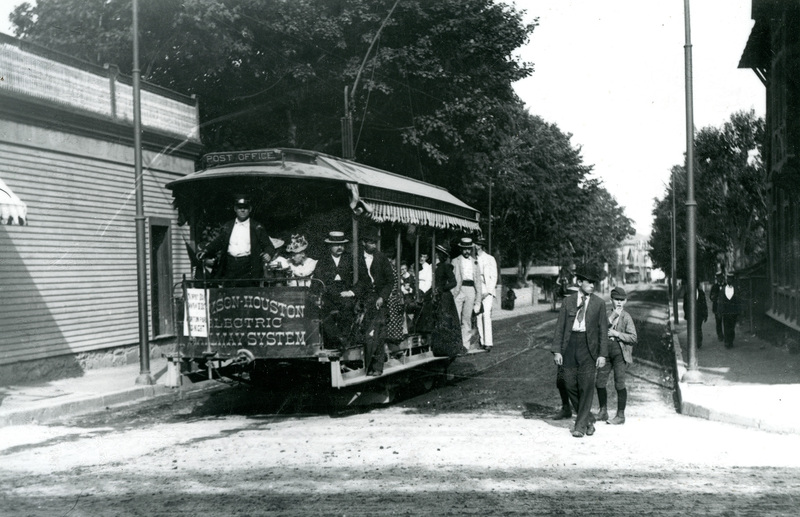
Newport in the spring of 1889 became the first Rhode Island community to use electric trolleys for mass transportation, but not without protest from the wealthy. This photograph shows a trolley stopped at the corner Memorial Boulevard and Bellevue Avenue in Newport. The trolley is full with passengers with a few standing on its ledge. The conductor looks towards the photographer (Providence Public Library Digital Collections)
Agitation resumed the following year in 1885. Summer residents presented petitions against horsecars and threatened to vacation elsewhere. Local resentment against carpetbagger arrogance, however increased. Others huffed about retainers who followed the rich to Newport, such as seasonal omnibus proprietors who took earnings elsewhere and paid no taxes. In 1886 the city council, under stepped-up local pressure, agreed, to put the question to a public vote which was affirmative. In 1887 the General Assembly granted a charter to the Newport Horse Railroad Company. Like Woonsocket, the incorporators misnamed the line a horse railroad when it was common knowledge that electricity would be attempted. One Newport councilman objected to authorizing rails across exclusive Bellevue Avenue “which he thought would be highly objectionable to the summer residents arid an injury to/the city.”
Plans went ahead, although few local investors bought stock, because of fear concerning a slow rate of return in such a seasonal city. Share’s sold surprisingly well in western states. The company’s directors planned an unusual technical strategy with both overhead and storage battery systems of electricity on different routes to see which worked best. Election traction remained a field without a definitive method.
By June 1889 the horse railroad company, newly rechartered as the Newport Street Railway, prepared to lay rails, in the face of several injunctions to halt construction altogether near the wharf and beach. Streetcars would impede “carriages from driving up to the most desirable point.” A curious kind of class warfare broke out in Newport that summer. Wealthy inhabitants banded together like a persecuted minority to stop encroachments by the detested railway. The continuing conflict “bids fair to separate families and sows dissension between bosom friends, so hot and long are the disputes concerning it.”

Electric trolleys and horse-drawn carriages at Easton’s Beach in Newport, circa 1890s (Providence Public Library Digital Collections)
A headline in the Providence Journal in late June 1889 read “The Summer People Meet and Declare War.” Prominent cottagers assembled at Ochre Point to chart a course of action. They named William Astor chairman because he was also involved in preventing subways in New York City.
They elected August Belmont president of the new organization, the Newport Improvement Association. Ironically, Belmont would, a few years later, build the New York City subway system. Cornelius Vanderbilt became treasurer. William W. Astor wrote to Senator Nelson W. Aldrich, future kingpin of electric traction in the rest of the state, asking him to speak before the association. Astor attacked public transportation in Newport, claiming “Such a road would be a standing danger to life, a serious detriment to the value of property, and an irreparable injury to the renowned beauty of the place.” Members planned to buy the railway and disband it. Pressure would also be applied “in a business way” on a number of local merchants who owned stock. Society members allegedly represented $10 million in property.
At the end of June, the Rhode Island Supreme Court denied an injunction requested by the Newport wealthy. Decorative poles and railroad tracks now pockmarked pristine Newport streets. In a society page column in the Providence Journal, an apprehensive writer noted that “it is announced as one of the pet plans of the dreaded and detested electric railway that an attempt is to be made to popularize Bailey’s Beach at the end of the avenue, hitherto rather overlooked by the barbarian hordes of excursionists.” A local minister who joined the Improvement Association mobilized his parishioners to oppose the railway. Some shopkeepers, influenced by the machinations of the wealthy, also publicly opposed the line. The city council held firm, since a number of its members were elected the previous September on a platform to support electric propulsion. The Association vowed to remove these politicians.
Despite the combined financial and social muscle of summer carpetbaggers, regular electric car service began on August 7, 1889. Crowds that cheered the beginnings of mass transportation in Newport acclaimed more than electric traction. Persistence and political participation overcame a formidable array of Gilded Age titans who failed to raise the capital necessary to buy out the road. A year later the Improvement Society sent another petition to the city council complaining about tracks in the streets. A Journal correspondent sarcastically paraphrased the plea: “It was the business of the city to take care of summer people . . . they objected to the progress of the 19th century here, although they liked it at home . . . we should supply all their wants, so far as possible, as had been done in the past.” The railway outlasted the objections, although the Improvement Society also lasted far into the twentieth century as a civic improvement group.
[Banner Image: Newport in the spring of 1889 became the first Rhode Island community to use electric trolleys for mass transportation, but not without a protest from the wealthy (Providence Public Library Digital Collections)]

